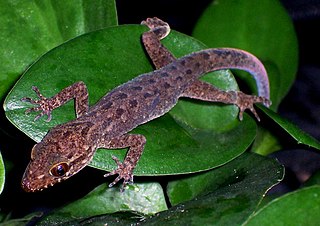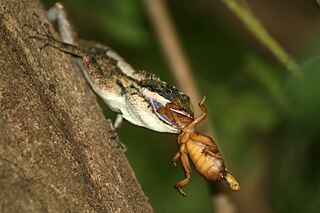
Cyrtodactylus is a diverse genus of Asian geckos, commonly known as bent-toed geckos, bow-fingered geckos, and forest geckos. The genus has 354 described species as of 2023, which makes it the largest of all gecko genera.

Calotes is a genus of lizards in the draconine clade of the family Agamidae. The genus contains 29 species. Some species are known as forest lizards, others as "bloodsuckers" due to their red heads, and yet others as garden lizards. The genus name Calotes has been derived from the Greek word Καλότης (Kalótës), meaning ‘beauty’, referring to the beautiful pattern of this genus.

Hardwicke's bloodsucker is an agamid lizard and found in South Asia.

Bronchocela cristatella, also known as the green crested lizard, is a species of agamid lizard endemic to Southeast Asia.

Calotes emma, commonly known as the forest garden lizard or Emma Gray's forest lizard, is a species of lizard in the family Agamidae. The species is native to China, South Asia, and Southeast Asia. There are two recognized subspecies.

Calotes mystaceus, the Indo-Chinese forest lizard or blue crested lizard, is an agamid lizard found in China, South Asia and Southeast Asia.

Monilesaurus rouxii, commonly known as Roux's forest lizard, Roux's forest calotes, or the forest blood sucker, is a species of arboreal, diurnal, agamid lizard, which is endemic to hills of peninsular India. In July 2018, it was proposed that the species should be transferred to the new genus Monilesaurus.

Pseudocalotes kakhienensis, the Kakhyen Hills spiny lizard or Burmese mountain agamid, is a species of agamid lizard found in southern China, Myanmar, India, and northern Thailand.
Microauris is a monotypic genus of agamid lizard. Its only species is Microauris aurantolabium, also known as the small-eared dragon or orange-lipped forest lizard, found in the forests of the southern Western Ghats and is currently known from the Kalakkad Mundanthurai Tiger Reserve. The species was formerly included in Pseudocalotes andamanensis of the Andaman Islands, but recognized as distinct in 2008. It was also classified under Calotes until 2018, where it was transferred to its own genus, Microauris, on the basis of its divergence from Calotes.

The Draconinae are a subfamily of reptiles in the family Agamidae found in southern Asia and Oceania. Some taxonomists believe these genera belong to the subfamily Agaminae.

Pseudocalotes andamanensis is an agamid lizard found on the Nicobar Islands and the Andaman Islands in India. It is also known as the green crestless forest lizard, Andaman and Nicobar forest lizard, Andaman lizard, or Andaman green calotes. This species is an almost exclusive canopy dweller, and is rarely seen.

Pseudocalotes microlepis, also known as Burmese false bloodsucker or small-scaled forest agamid, is a species of agamid lizard in the genus Pseudocalotes found in southern China, Thailand, Laos, Myanmar and Vietnam.
Bronchocela smaragdina, also commonly known as Günther's bloodsucker, is a Southeast Asian species of agamid lizard.

Calotes ceylonensis, commonly known as the painted-lipped lizard or the Ceylon bloodsucker, is a species of lizard in the family Agamidae. It is one of four Calotes species endemic to Sri Lanka.

Pseudocalotes floweri, also commonly known as Flower's forest agamid, Flower's long-headed lizard, and the Thai false bloodsucker, is a species of lizard in the family Agamidae. The species is native to Southeast Asia.
Bronchocela hayeki, also known commonly as the Sumatra bloodsucker, is a species of lizard in the family Agamidae. The species is endemic to Indonesia.

Pseudocalotes dringi, also known commonly as Dring's false bloodsucker and Dring's false garden lizard, is a species of lizard in the family Agamidae. The species is endemic to Malaysia.
Pseudocalotes flavigula, the Malaya false bloodsucker, yellow-throated forest agamid, or yellow-throated false garden lizard, is a species of agamid lizard. It is found in Malaysia.
Pseudocalotes viserion, also known as Viserion's false garden lizard, is a species of agamid lizard found in the Genting Highlands, Pahang, Peninsular Malaysia.














